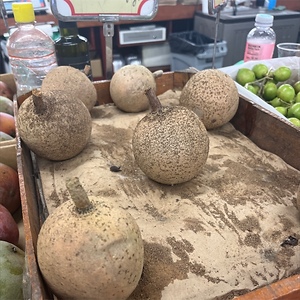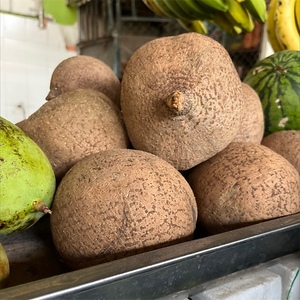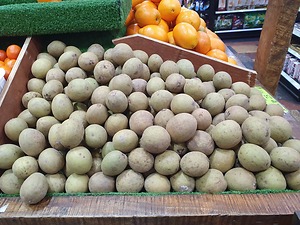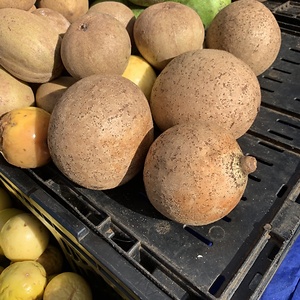

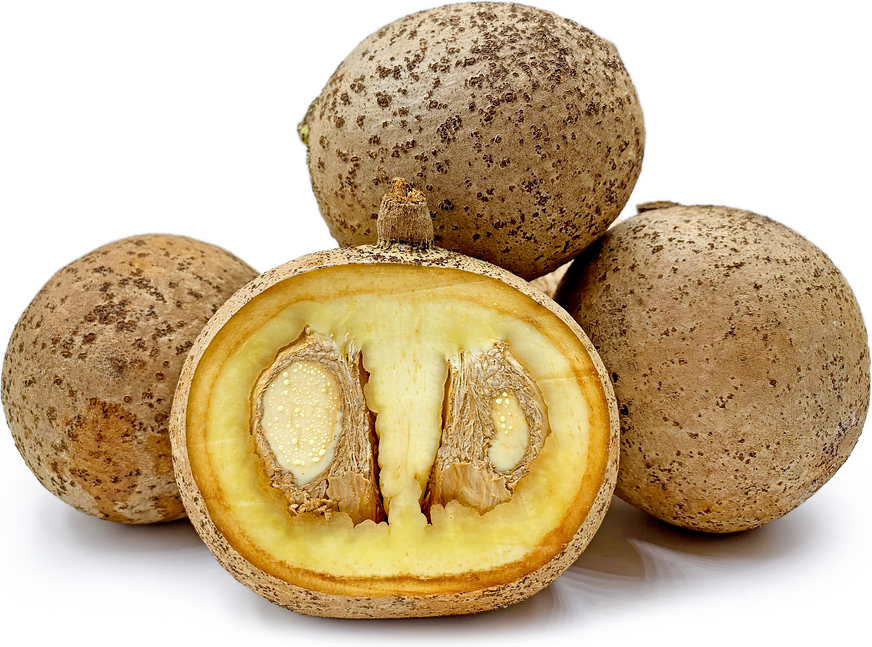
Mamey Apple
Estimated Inventory, lb : 0
Description/Taste
Mamey apples are a round tropical fruit that measures 7 to 15 centimeters in diameter. They have an egg-like shape with light brown-grey skin similar in color to a kiwi or brown coconut. This skin has a rough, wood-like appearance with a texture and firmness similar to that of a mango. Mamey apples’ flesh is golden-yellow with a smooth consistency that can either be firm and crisp or more tender and juicy depending on their level of ripeness. Within the flesh are seeds similar to peach pits. Smaller Mamey apples may have one seed but larger ones can have up to four. The portion of the flesh nearest to the seeds may be slightly bitter. Mamey apples' taste is sweet with notes of passion fruit, apricot, and berry as well as a hint of tanginess.
Seasons/Availability
Mamey apples are available from spring to fall in tropical climates. In temperate regions, the fruits are primarily found in the summer.
Current Facts
Mamey apples are tropical fruits botanically classified as Mammea americana and belong to the Calophyllaceae family. This variety is known by many different names in various languages, including St. Domingo apricot, Mamey Amarillo, Zapote Mamey, Abrico do Pará, Abricot d'Amérique, and Mata Serrano. They are closely related to the mangosteen, a Southeast Asian fruit from the island of Borneo. Mangosteen has a distinct, puffy white flesh and like Mamey apples, possesses a tangy taste with flavors that resemble those of various fruits. Mamey apples have uses beyond their culinary practices. The fruit releases a natural, sticky gum-like substance that has been used as a natural glue and for treating skin-infesting chigoe fleas that chickens are vulnerable to. The resinous seeds from the fruit have also been useful as an antiworming agent.
Nutritional Value
Mamey apples are an excellent source of vitamin C, which supports immune function and skin health, and vitamin A, important for vision and cell growth. Thiamin and riboflavin in Mamey apples help convert food into energy and support overall cellular function. The fruit also contains copper, which aids in the formation of red blood cells and the absorption of iron, and magnesium, essential for muscle and nerve function. The iron and folate in this variety support oxygen transport in the blood, DNA synthesis, and cell division.
Applications
Mamey apples are often eaten fresh. To peel, remove the stem and opposite end, score the fruit, and peel off each section. Then either cut away the flesh from the seed or cut the fruit in half and remove the seeds. Mamey apple pulp can be stewed with sugar and lemon juice or made into sauces, salad dressings, syrups, and purées for baked goods like pies, tarts, and muffins. They contain pectin, ideal for creating jams, preserves, and marmalades. The diced fruit pairs well with berries, tropical fruit, and salads. They can be used as an ingredient in ice cream or smoothies along with almond milk, vanilla, and cinnamon. These fruits pair well with bananas, papayas, pineapple, plantains, limes, lemon, ginger, nutmeg, basil, pecans, salad greens, whipped cream, coconut, olive oil, salmon, pork, and grilled chicken. They do not have a long shelf-life once ripened and should be refrigerated and consumed within a few days.
Ethnic/Cultural Info
Mamey apples are highly valued in the Caribbean where they are a protected species in many areas. In the French West Indies, the flowers from their tree are distilled with wine to create a liqueur called Eau Créole that can double as a tonic or digestive. This drink often includes ingredients like pineapple, passion fruit, lime, cinnamon, and cloves. In Jamaica, the fruit is cooked with wine and sugar and served either warm or cold as a dessert. In the Dominican Republic, Mamey apples are popularly frozen and blended with sugar to create sherbet.
Geography/History
Mamey apples are native to the West Indies and the northern part of South America. The earliest record of them was found in Panama in 1514 and later written about in 1529 by Gonzalo Fernández de Oviedo y Valdés in his work, “Review of Fruits of the New World.” Mamey apples were later introduced to West Africa and then brought to Hawaii by Captain Alexander Adams in 1816. To this day, they continue to grow on the Big Island of Hawaii. Mamey apples flourish in tropical climates with full sun exposure but can adapt to a wide variety of soils and are moderately tolerant of drought. They are most popular in South America, Santo Domingo, Puerto Rico, Martinique, Jamaica, the Bahamas, Mexico, Hawaii, and Florida. In all of these places, they may be found growing in tropical gardens or sold at markets. Outside of these areas, Mamey apples are relatively rare.
Recipe Ideas
Recipes that include Mamey Apple. One
| Cooking Sense |
|
Caribbean Apricot ( Mammee Apple) Jam |



